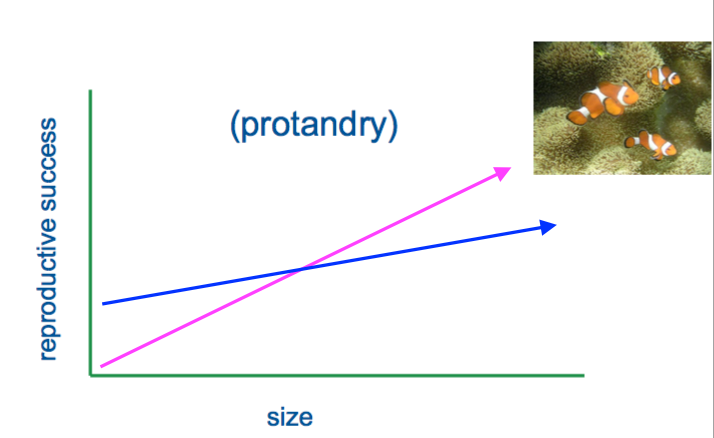Cycle 7
Why Sex?
- reproducing sexually generates new multilocus combinations of alleles
- sex generates genetic diversity, new haplotypes
- sexual recombination creates genetically unique offspring therefore the offspring has both of its parents DNA
- genetic exchange is not always associated with reproduction
- obligately asexual: reproduce by parthenogenesis (ovum but no fertilization)
- facultatively asexual: can reproduce as/sexually
- ex. bacteria transfer genetic material through their mating tube to another
 bacterium… no sex
bacterium… no sex
Monoecious: same individual is male and female in one, reproduces sexually
- Sequential Monoecy: start life as one sex then switch later, ex. clown fish switch to female later in their lives when they are big enough

- protandry: maleness occurs first in lifetime
- protogyny: female then male
- Simultaneous Monoecy: both sexes at the same time (hermaphrodites)
Dioecious: separate sexes in separate individuals, reproduce sexually
Sex Ratio Manipulation
- Non-hermaphrodites also need to balance male and female function
- if it is in relatively good condition (lots of resources), they might tend to produce sons
- if not in good condition = more daughters, because most girls can reproduce so theres less to lose,
- because the male offspring will have poorer conditions, and may not be as strong as competing male, resulting in less sexual fitness.
- If a female is produced instead, it will have a higher sexual fitness even in poor condition, since males compete for access to the female
History of Sex
- The first living things, and the first eukaryotes, reproduced asexually
- meiosis and ‘normal’ diploid sex probably appeared ~ 1.5 BYA
- isogamy (equal-sized gametes) in females and males appeared first, then anisogamy (unequal gamete sizes), females have larger but fewer gametes, whereas males have smaller but more gametes
- most living things reproduce mostly asexually; plants and animals are the exceptions
Benefits of Sexual Reproduction
- increases speed of evolution
- rate at which disadvantageous mutations can be killed off (“survival of the fittest”)
- continually creates new genotypes with fewer harmful mutations (“rubies in the rubbish”) by the luck of the draw from the gene of each parent
- rate at which advantageous mutations can be brought together (allows advantageous mutations to come together in the same individual more quickly, success mutation in mom and dad)
- decreases the likelihood of extinction
- Sexual recombination “breaks the ratchet”
- Muller’s ratchet: asexual lineages accumulate harmful mutations
- Lottery Principle: buy many copies of the same ticket, or hedge your bets?
- hedging your bets increases the likelihood that some of your offspring will be better adapted to the environment because sexual reproduction produces different genotypes and more variation in the offspring
- Red Queen Principle: “it takes all the running you can do, to stay in the same place”
- our environment involves other living things that want to eat us , infect us.. etc, therefore organisms are locked in the evolutionary arms race
Costs of Sexual Reproduction
- not exposing yourself to the risks of putting yourself out there (wasted energy on rejection or making yourself more obvious to predators)
- males cannot grow the population, therefore there’s costs associated with producing sons
- grows half as fast as asexually producing populations because males
- complicated way of getting gametes to offspring, because there are errors in meiosis
Asexual Reproduction
- Disadvantage: can only move in one way … like a zipper, no way to get rid of mutations unless the individual dies
- keeps accumulating mutations until its has so many the pop. goes extinct
- favoured if the environment is stable because that means the traits are an individual has are pretty good therefore they will just make copies of themselves
Selection of Males vs. Females in Sexual Reproduction
- males increase fitness by having many mates, therefore they take any mating opportunity they can (higher potential fitness)
- females are physiologically constrained, therefore they want to maximize the quality of the offspring by selecting the mate
- equal sex ratios & each offspring has a mom & dad therefore on average males & females have the same fitness
- dimorphic traits favoured by sexual selection, increases the mating success of individuals, therefore it increases their fitness, different between the sexes, decreases survival due to costs (risk of putting yourself out there)
- Sex differences in parental investment and potential fitness determine which sex is choosy, and which sexy competes
- males usually compete because they want to maximize their fitness, while women want to select the mate of best quality to maximize their fitness (due to limited supply of eggs)
- the parent that invests more into the offspring is often the choosy parent, making the other parent the competitive sex
- Indirect benefits attractive individuals have good genes
Intrasexual Selection: male-male competition, direct benefits attractive individuals are good parents
Intersexual Selection: female choice, indirect benefits attractive individuals have good genes